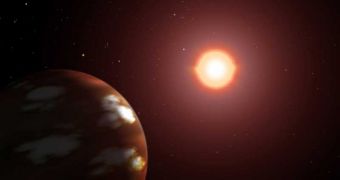In 1996, the first ever when a planet outside the solar system has been detected, by measuring the wobble in the stars' position, as the planet pulled on its surface. Since then, more than 250 exoplanets have been discovered; however most of them either are gas giants, or do not present the necessary properties to make them more Earth-like, thus suitable for the evolution of life.
Out of the multitude of gas giants found spinning around their stars, a small fraction is represented by large rocky planets, some of them with a mass more than 10 times that of Earth, which scientists call Super-Earths.
As of April this year, two new planets have been found around an M class star, named Gliese 581, with masses somewhere between 5 to 8 that of the Earth. Observations showed that they most probably orbited their old star, in a region of space which could possible present the planets with habitable characteristics. Unlike the previously discovered planets which were gas giants, more than a few times the mass of Jupiter, the objects discovered around the Gliese 581 appear to have a rocky surface, making them the first ever exoplanets that candidated for the position of habitable planets.
So far, not much is known about these planets, but future observations would reveal the content of their atmosphere, through light spectroscopy methods that would reveal eventual gases specific to the presence of life.
The investigation team currently consists of two groups, one in charge with determining if the planets are indeed located in the right positions around the star to enable the existence of liquid water, and the other studying the planets' atmospheric properties in certain key distances, to see how they would behave, and if they provide chances for life to evolve. If the planet is too close to the star, all the water on its surface will be vaporized, and life could not appear; if it is too far way, the water might freeze. However, the planet could warm up through a greenhouse effect if any gaseous carbon dioxide is present in the atmosphere, and through the balance between the greenhouse gases present in the atmosphere and liquid water content on the planet, which greatly affects the photosynthesis process.
However, the current models suggest that the photosynthetic biosphere process strongly depends on the age of the planet, as an old planet would not emit very much gaseous content, resulting in a no longer habitable environment.
Both of the investigation groups found that, while one of the planets is too close to its star for life to appear and evolve, the second one seems to be in a habitable zone, and is tidally locked to its star, meaning it always shows the same face towards it. The possibility that one of the planets could be habitable represents a very interesting aspect as more than 75 percent of the star population of the Milky Way is represented by M class stars, which are red dwarfs, stable old stars, burning hydrogen fuel.
Tidally locked planets present two different situations, in which they can lose their atmosphere, thus not being able to support life. One might be that the planet's atmosphere might freeze, on the dark side, and secondly, it could be blown off by violent ultraviolet and x-ray radiation emitted by the star.
Nevertheless, all theoretical studies show that M class stars do not permit their planet to have conditions proper for life to appear and evolve; however, they can provide astronomers with valuable data on how to detect future Earth-like planets orbiting other stars than M class stars.

 14 DAY TRIAL //
14 DAY TRIAL //